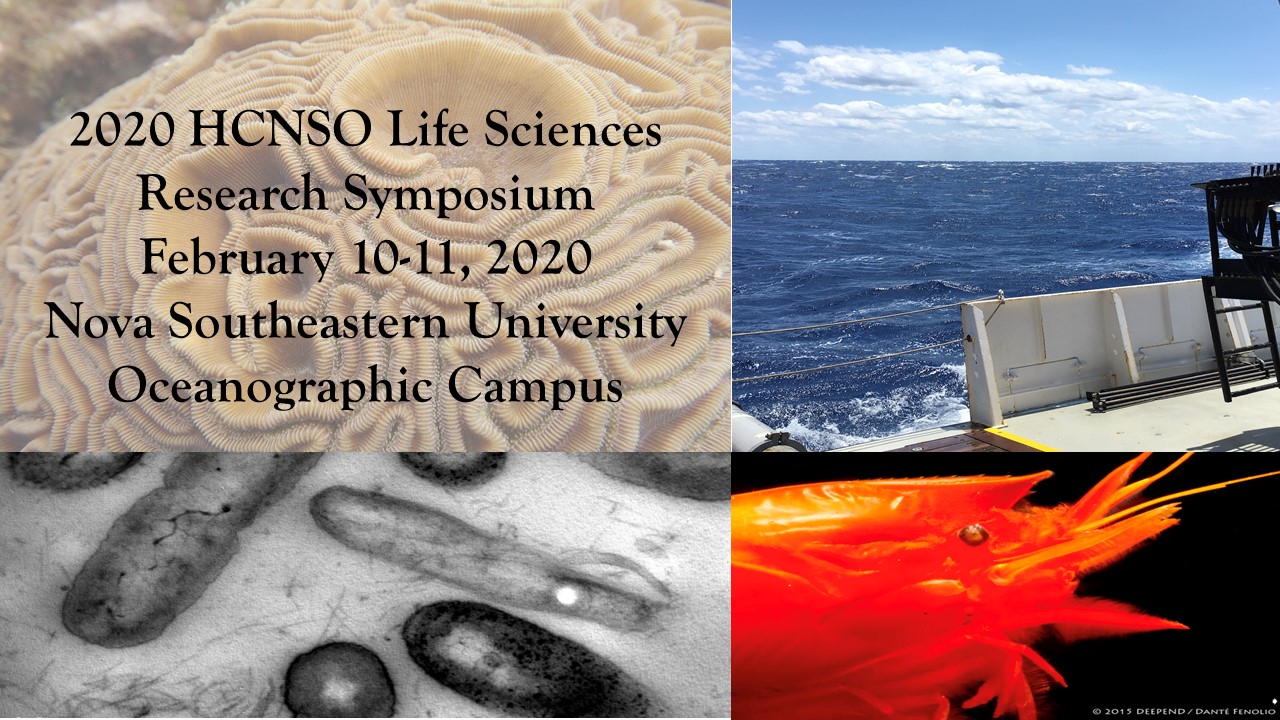Title
Coral restoration and monitoring efforts at Great Stirrup Cay, The Bahamas
Location
HCNSO Guy Harvey Oceanographic Center Nova Southeastern University
Start
2-11-2020 11:15 AM
End
2-11-2020 11:30 AM
Type of Presentation
Oral Presentation
Abstract
In recent decades, coral reefs have declined due to local and global stressors. To promote recovery, restoration efforts in the Caribbean have been implemented for many coral species, particularly within the genus Acropora. In 2017, Nova Southeastern University, in conjunction with Norwegian Cruise Lines and the Perry Institute of Marine Science, developed multiple goals for restoration efforts around Great Stirrup Cay (GSC), The Bahamas. These included establishing an in situ acroporid coral nursery, outplanting nursery grown corals, collecting annual benthic monitoring data, monitoring wild acroporid colonies, and conducting an annual coral recruitment study. Data collected from the coral nursery was included as part of a thesis study, which investigated parameters to optimize fragment growth and survival among all three Caribbean acroporid coral taxa (Acropora cervicornis, A. palmata, and A. prolifera). Experimental corals were collected from wild colonies around Nassau, The Bahamas, and transported to GSC. The clippings were cut into three fragment types (apical, middle, and basal) and attached to replicate nursery trees at three sites. Linear growth, mortality, and condition data were collected monthly for 13 months. Fragments were differentiated by site, taxon, and genotype for statistical analysis. Nursery location significantly affected fragment survival, with fragments at the site closest to exposed reef having greater probability of survival than those near sand flats and sea grass beds (p<0.05). Site, fragment type, and taxon influenced total linear extension (growth), with apical A. prolifera fragments closest to exposed reef having the greatest growth. This nursery study highlights the importance of careful consideration of taxon, nursery location, and fragment type to optimize coral growth and survival within a nursery. Coral restoration managers may benefit from capitalizing on fast growing hybrids and apical fragments for outplanting to degraded reefs and increasing the scale of nursery projects.
Coral restoration and monitoring efforts at Great Stirrup Cay, The Bahamas
HCNSO Guy Harvey Oceanographic Center Nova Southeastern University
In recent decades, coral reefs have declined due to local and global stressors. To promote recovery, restoration efforts in the Caribbean have been implemented for many coral species, particularly within the genus Acropora. In 2017, Nova Southeastern University, in conjunction with Norwegian Cruise Lines and the Perry Institute of Marine Science, developed multiple goals for restoration efforts around Great Stirrup Cay (GSC), The Bahamas. These included establishing an in situ acroporid coral nursery, outplanting nursery grown corals, collecting annual benthic monitoring data, monitoring wild acroporid colonies, and conducting an annual coral recruitment study. Data collected from the coral nursery was included as part of a thesis study, which investigated parameters to optimize fragment growth and survival among all three Caribbean acroporid coral taxa (Acropora cervicornis, A. palmata, and A. prolifera). Experimental corals were collected from wild colonies around Nassau, The Bahamas, and transported to GSC. The clippings were cut into three fragment types (apical, middle, and basal) and attached to replicate nursery trees at three sites. Linear growth, mortality, and condition data were collected monthly for 13 months. Fragments were differentiated by site, taxon, and genotype for statistical analysis. Nursery location significantly affected fragment survival, with fragments at the site closest to exposed reef having greater probability of survival than those near sand flats and sea grass beds (p<0.05). Site, fragment type, and taxon influenced total linear extension (growth), with apical A. prolifera fragments closest to exposed reef having the greatest growth. This nursery study highlights the importance of careful consideration of taxon, nursery location, and fragment type to optimize coral growth and survival within a nursery. Coral restoration managers may benefit from capitalizing on fast growing hybrids and apical fragments for outplanting to degraded reefs and increasing the scale of nursery projects.


